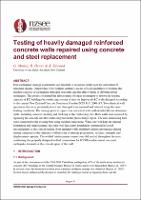Testing of heavily damaged reinforced concrete walls repaired using concrete and steel replacement

Download
Date
2023-04-19Authors
Muñoz, Gonzalo
Henry, Richard
Elwood, Kenneth
Metadata
Show full item recordAbstract
Post-earthquake damage assessments are essential to decisions on the need for and extent of structural repairs. Despite this, New Zealand currently has no official guidelines to evaluate the residual capacity of earthquake-damaged structures and the effectiveness of different repair techniques. This project evaluated the effectiveness of repair techniques to restore the seismic capacity of RC buildings by conducting a series of tests on large-scale RC walls designed according to the current New Zealand Concrete Structures Standard NZS 3101:2006 A3.
Two identical wall specimens that were previously tested and damaged were repaired using different approaches and retested using the same loading conditions. The damage prior to repairs was consistent with well-detailed flexure dominant walls, including concrete crushing and buckling of the reinforcing bars. Both walls were repaired by replacing the concrete and the reinforcing bars in the plastic hinge region. The new reinforcing bars were connected to the existing bars using welded connections. While one wall kept its original foundation and reinforcement, the other wall had a new foundation constructed to avoid discontinuities at the critical section. Both repaired walls exhibited similar performance during testing compared to the reference wall in terms of damage progression, stiffness, strength, and displacement capacity. The welded reinforcement connections did not fail throughout the tests, confirming that properly designed welded connections for G500E reinforcement can resist earthquake demands at the critical region of the wall. A summary of the wall repair and test results will be presented along with conclusions and recommendations resulting from the study.
